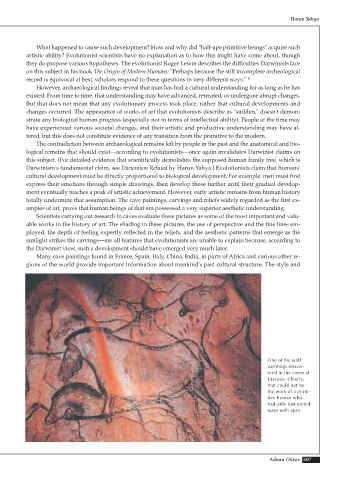Page 509 - Atlas of Creation Volume 2
P. 509
Harun Yahya
What happened to cause such development? How and why did "half-ape primitive beings" acquire such
artistic ability? Evolutionist scientists have no explanation as to how this might have come about, though
they do propose various hypotheses. The evolutionist Roger Lewin describes the difficulties Darwinists face
on this subject in his book The Origin of Modern Humans: "Perhaps because the still incomplete archeological
record is equivocal at best, scholars respond to these questions in very different ways." 9
However, archaeological findings reveal that man has had a cultural understanding for as long as he has
existed. From time to time, that understanding may have advanced, retreated, or undergone abrupt changes.
But that does not mean that any evolutionary process took place, rather that cultural developments and
changes occurred. The appearance of works of art that evolutionists describe as "sudden," doesn't demon-
strate any biological human progress (especially not in terms of intellectual ability). People at the time may
have experienced various societal changes, and their artistic and productive understanding may have al-
tered, but this does not constitute evidence of any transition from the primitive to the modern.
The contradiction between archaeological remains left by people in the past and the anatomical and bio-
logical remains that should exist—according to evolutionists—once again invalidates Darwinist claims on
this subject. (For detailed evidence that scientifically demolishes the supposed human family tree, which is
Darwinism's fundamental claim, see Darwinism Refuted by Harun Yahya.) Evolutionists claim that humans'
cultural development must be directly proportional to biological development. For example, men must first
express their emotions through simple drawings, then develop these further until their gradual develop-
ment eventually reaches a peak of artistic achievement. However, early artistic remains from human history
totally undermine that assumption. The cave paintings, carvings and reliefs widely regarded as the first ex-
amples of art, prove that human beings of that era possessed a very superior aesthetic understanding.
Scientists carrying out research in caves evaluate these pictures as some of the most important and valu-
able works in the history of art. The shading in these pictures, the use of perspective and the fine lines em-
ployed, the depth of feeling expertly reflected in the reliefs, and the aesthetic patterns that emerge as the
sunlight strikes the carvings—are all features that evolutionists are unable to explain because, according to
the Darwinist view, such a development should have emerged very much later.
Many cave paintings found in France, Spain, Italy, China, India, in parts of Africa and various other re-
gions of the world provide important information about mankind's past cultural structure. The style and
One of the wall
paintings discov-
ered in the caves at
Lascaux. Clearly,
that could not be
the work of a primi-
tive human who
had only just parted
ways with apes.
Adnan Oktar 507

